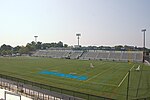Johns Hopkins School of Education
The Johns Hopkins School of Education is one of nine academic divisions of the Johns Hopkins University. Established as a separate school in 2007, its origins can be traced back to the 1876 Founding of Johns Hopkins’ College Courses for Teachers, later renamed College for Teachers. It was ranked first in the nation among graduate schools of education in 2015 by U.S. News & World Report.Program offerings, including both online and face-to-face, range from initial licensure master's degrees for those entering the teaching profession to advanced doctoral level research designed to prepare future scholars to address preK – 12 policies and practice challenges from early childhood to the adult learner. The School has three centers; the Center for Research and Reform in Education, the Center for Social Organization of Schools, and the Center for Technology in Education. They are home to some of the nation's most recognized academics and practitioners in educational research and among the top recipients of U. S. Department of Education. It grants for programs aimed at improving educational outcomes for students. The Johns Hopkins School of Education is accredited by the Council for the Accreditation of Educator Preparation (CAEP), formerly the National Council for Accreditation of Teacher Education, and the Council for Accreditation of Counseling and Related Educational Programs (CACREP). All programs leading to certification are approved by the Maryland State Department of Education. The Johns Hopkins University is accredited by the Middle States Commission on Higher Education (MSCHE).
Excerpt from the Wikipedia article Johns Hopkins School of Education (License: CC BY-SA 3.0, Authors).Johns Hopkins School of Education
North Charles Street, Baltimore
Geographical coordinates (GPS) Address Website Nearby Places Show on map
Geographical coordinates (GPS)
| Latitude | Longitude |
|---|---|
| N 39.327443 ° | E -76.620777 ° |
Address
Johns Hopkins University
North Charles Street 3400
21218 Baltimore
Maryland, United States
Open on Google Maps






